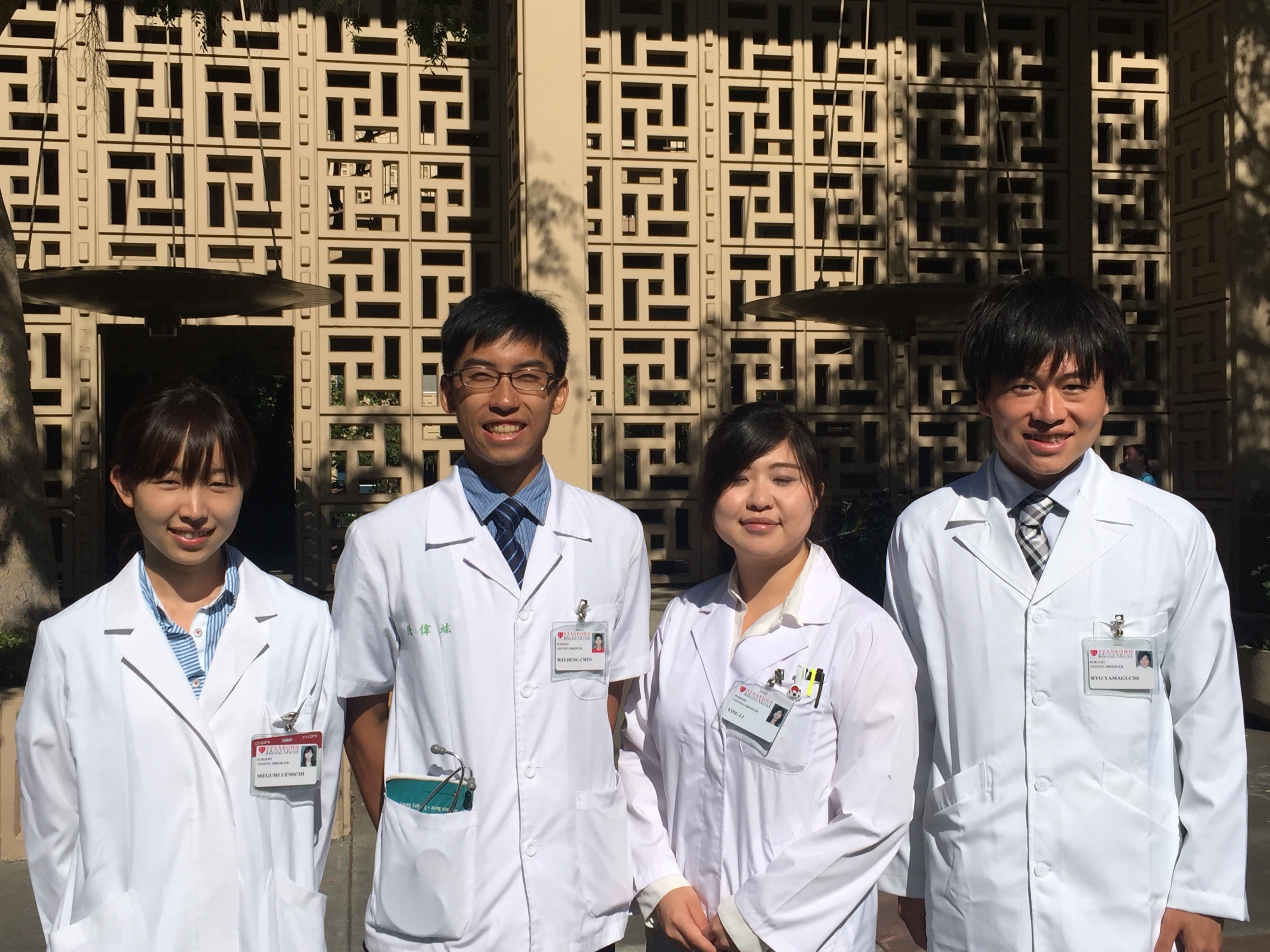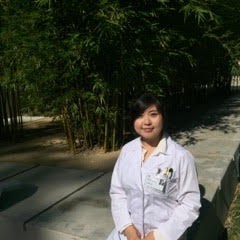Eriko Yoshida
I am Eriko Yoshida, 5th year student in Keio University. I shadowed Dr. Mitarai at Stanford Hospital Emergency Clinic. This was one of the most impressive experiences for me in this program.
The U.S. emergency system(ER) is different from Japanese one. In the U.S., no matter how serious their condition, patients can go to any emergency departments. In Japan, on the other hand, hospitals are divided into three grades: first grade hospital is for slight illness. Third grade hospital is for very severe illness. The range of diseases hospitals can treat has been decided according to this grade. Ambulance crew and patients have to choose which hospital they take patients in. In the past, choosing a hospital appropriate for a patient were often difficult and the patient had trouble looking for hospital because hospitals sometimes refused to accepting them. It sometimes threatened patients’ life.
These day Japanese hospitals are adopting the U.S. system, ER, so hospitals expand their limits and start to accept any patients. However, there are still some problems. First, hospitals have to raise ER doctor who can see surgery field and internal medicine field, it is hard for Japanese present education system. And there are still three grades in hospitals, so even if they were named ‘ER’, there is some imbalance specialities. Above all is what I studied for ER shadowing. By going ER actually, I could feel for the atmosphere in the ward. This experience was so stimulating me.
I learned a lot from this shadowing and this whole MED program. What I thought it was natural was not natural here. What I thought it was impossible was possible here. I was used to Japanese values and system, and have accepted them naturally, but I realized that I should know as many differences as I can when I find a new way. Through this shadowing, I could get a precious opportunity to learn a lot.
Erina Hamada
I shadowed in Stanford Emergency Room on August 13th. This was my first shadowing experience. To be honest, it was a difficult experience due to several factors. Sometimes I wasn’t able to understand the medical terminology and the conversation speed was too fast between Dr Mitarai and his patients and residents. Despite it being a challenging experience, it was also very exciting. Through shadowing, I found several differences in the ER between the US and Japan.
First, there are interpreters available in the American ER. In the US, patients come from a variety of backgrounds. Some patients can’t understand English. In that case, an interpreter helps facilitate the conversation between the doctor and the patient. If there is no interpreter of the language, they would use an iPad. I saw Spanish interpreter interpret the conversation. It was really interesting to me. In the near future, the Olympic Games are going to be held in Tokyo. Accompanied by this, many foreigners will visit hospital. I strongly think that we will need some interpreters in hospitals in Tokyo, too.
Also, I realized that ER in the US has different systems from that in Japan. In Japan, we accept only patients who are in the severest level of condition. However, in the US, they accept all the patients. We shadowed early in the morning and the ER wasn’t so crowded. However, in the evening there are more patients, Dr Mitarai said. Also, in the US, it matters that if the patients buy insurance or not, and what kind of insurance they have. It is because there are many kinds of insurance in the US and which treatment will be covered is really different depending on the insurance.
Finally, I was so impressed by the way Dr. Mitarai works as a doctor. Whenever he talks to patients, he is gentle and kind. He listened to patients carefully. Also he communicated with other members in the ER such as, residents, nurses, interpreters and social workers. They share information and discuss the patients’ conditions, possible diagnoses and treatments actively. I felt the teamwork there was really strong and everyone was cooperative with each other. They have good relationships with one another.
Shadowing in the ER was really precious experience. After going back to Japan, I’d like to share my experience with my friend, study more about the differences and deepen my knowledge.
Ying Linda Li
I was so glad that I could have a chance to go shadowing in the Emergency department at Stanford Healthcare Center. I always have interest in ER since I was a high school student. It is one reason that I decided to come to med school and become a doctor in the future. I know there are 2 types of emergency room systems in Japan; one is Japanese original system and the other is new system, so called Northern American system, which our university hospital is currently using for ER. I wanted to explore the similarities and differences between the original ER system in the U.S. and the one we are using in our hospital through the shadowing.
To tell the truth, I though there should be a lot of difference than similarities between the two systems before the shadowing, but what I found is that we have so many things in common. For example, in both systems, doctors have to see all the patients who come to the ER, no matter how severe it is. There are triage nurses to ask you some questions before doctors see the patients. System itself just looks the same. Doctor’s way of thinking to come up with differential diagnosis are also pretty much the same.
On the other hand, I did find many differences between the two. I want to share some of them. First, there was an emergency room only for pediatrics. There have TV, iPad, books, and games to let children play while waiting their siblings being take care of or to distract the children’s attention from painful treatment they will have. Second, there were a lot of staffs working as a team in the emergency department, including attending doctors, residents, nurses, interpreters, and all the other co-medical workers. We won’t have that much staffs in ER in Japan. Third, the residents were so responsible for their patients. Even through they have to do case presentations to their attending doctors, they seemed to have their own problem solving way and they are much more confident about what their offering to their patients. Lastly, the most remarkable difference I have found is that in the Stanford ER, they have a system to follow each patients’ status such as their waiting time, which bed they are in, what language they speak, who are in charge of them, the severity of them, and so on. All of the information was shown on both big screen and individual PC so that everyone could take a look easily.
I was so proud of my university hospital having same system as the ER in the U.S. ThoughI think there also have so many points to improve more to be better place to our patients. Shadowing Dr. Mitarai was definitely a life changing experience. It was a little hard to understand his talking with the residents, but it was a very precious challenging for me to keep my brain synapse work very hard to catch up on them. Knowing how their way of thinking and discovering those similarities and differences were coolest thing for me.
In the end, I want to thank you all to make the shadowing happen. Shadowing in the emergency department was the most impressive 90 minutes I had in this program. Thank you very much, again.
Wakako Chino
I had an opportunity to shadow Dr. Tsuyoshi Mitarai at Stanford Emergency Medicine Department on August 13th. I had a great experience and I would like to share my thoughts and what I learned through my shadowing.
Total of 8 students shadowed and we were divided into 2 groups with 4 people in each. I imagined ER to be more crowded and busy but it was surprising to notice that it was quiet and well organized. Although this may be because I shadowed in the morning.
ER in the United States is very different from Japan because we have a different system. When a patient calls an ambulance they will be taken to the nearest hospital. They will be seen by a triage nurse who would decide how severe the patient is. Depending on the severity, the patient will immediately be seen by a doctor. If the patient has a severe pain, pain medication could be given in the waiting room. Patients will first be seen by residents who will take the history of the patient. After presenting to the attending doctor about the case they will discuss about the treatment and plans. Job required for each worker is divided and providers work as a team. Compared to this in Japan, ambulance select the hospital by the severity of the patient which leads to problems where some hospitals refuses to take patients. Also most of the works needed to treat the patient will be done by doctors. I think these differences change the speed it takes for a patient to be treated and patients are treated faster and the amount of time patients stay in the ER are less in the United States giving the ability to see more patients who need care. ER system in the United States is well organized.
Nonetheless, there are some problems to consider in the ER. I observed an interesting case that showed one of the problems of health care. The case was about a patient who visited ER several times with a similar abdominal pain. Since the patient was refusing to take treatment and had many ER visits in the past, the doctor called social worker for a consult. The social worker will try to find the non-medical issue that the patient may be having. Similar to this case, there are patients who come back to the ER just for shelter, food or medication. In the United States it is illegal to refuse treating a patient who comes to the ER and every patient must be treated. Since these patients have social difficulties it is hard to solve this problem.
Through my experience in shadowing the ER and also through this program, I have realized that the difference in health care mostly comes from cultural difference. I had a feeling that in the United States people think more as an individual compared to Japanese think as all in one. Before coming to this program I have thought that medical health care in the United States is better than Japan. However there are both pros and cons to the system, and using the ER system in the United States wound not solve the medical problem in Japan. Such problem is patients being sent around by ambulance. To improve health care system in Japan I think we need to divide works that the medical staffs do and work more as a team. Benefits to this are workers will have high knowledge and more deep care to patients. They will have more responsibility to work and have high motivation to work. Also doctors will have more time to educate residents or medical students. In order to do this, I think the first thing to do now is to develop a stronger communication between medical workers. We should make an environment so that people feel free to share their opinion.
Lastly, I was able to learn so much from these experiences and I appreciate Dr. Tsuyoshi Mitarai for giving me this opportunity and his understanding. I also want to thank the program director and assistant director for organizing and supporting this shadowing.
Ryo Yamaguchi

Before I move onto my shadowing in Stanford Emergency Department, I would like to share the experience of preparation for this shadow. Stanford requires us to do HIPAA training on the Stanford website, and to have Stanford ID. In HIPAA training, I got to work with the other students who would shadow in the same place and passed it after hours of struggles, mostly thanks to Ellison. Speaking of Stanford ID, I went to the security department of Stanford hospital to have my photo ID taken. To have Stanford ID with my photo on it was super cool.
At the day of shadowing, my morning started early at 6am compared with ordinary days. We gathered at 7am in the lobby of Roble Hall and headed to the hospital. At 8am, we encountered Dr.Mitarai who I shadowed and my shadow started. Firstly, he showed us around patients’ waiting room where nurses take each patient’s triage and then moved to emergency team unit. He explained about a screen hanging on wall which has some information about patients such as types of patients, which room they are in, etc. This system seems very convenient as you can see patients’ brief information at a glance. Then we got to hear about Dr.Mitarai’s patients information and he explained to us about them. The way he explained to us and he did to residents or other medical team was totally different, which means he kindly treated us. Luckily, we got access to 4 patients info and could see 3 patients of it with him. When he explained about a patient with RLQ stabbing pain and diarrhea, he asked us for differential diagnosis. At that time I only hit up appendicitis even though I know many other differential. I felt very useless because I could not use my medical knowledge in clinical clerkship. This was my first time to do clinical clerkship, and I might be a bit nervous. I guess it would be also important not only to study with books but to express what I have learned. I meant that it would be better not only to accumulate knowledge but to output it.
From my shadowing, I also obtained the difference between Japanese medical emergency room and American. In Japan, the number of ER system like U.S. is getting increasing. Still our emergency is totally different from them and I could learn lots of things to improve our system from them. I have not had so much time to spend thinking about even our health care system, but I would learn it more after going back to Japan.
Though it was a pity that we could not shadow for long, I somehow learnt many things. I hope I can come back to Stanford as a doctor one day.
Megumi Uemichi
Wei-Hung Rocky Chen
Since emergency department (ED) is the frontier of medicine, I constantly wonder what the work content is in ED in my freshman year. Therefore, I had signed up for volunteering in ED in the associate hospital of my school, NTU hospital, NTUH, when I was a second grader. However, this couldn’t satisfied me, so I choose ED as my shadowing place in the MED program.
I shadowed the Dr. Mitarai in Aug.13th. He explained some cases in the ED of Stanford hospital, introduced its environment and demonstrated the skills of physical examination on the bedside for us. Besides, we also heard some of the ED resident presenting cases to the attending doctors. After that, I found there are several differences in ED between America and Taiwan.
First of all, the hospital in Taiwan don’t have strict hospital grading hierarchy and transferring system, so it is difficult for us to develop life flight system which can transfer critical patients from the other hospitals to medical centers or rescue life-threatening patients from an inaccessible area. However, we still have overpopulated emergency room in Taiwan.
Next, we have distinct space arrangement. In Stanford, they divide ED into two part: one is for adult, and the other is for children where they put some toys and cute decoration there. In NTUH, we divide ED into two part: one is for outpatients who need the treatment of internal medicine, the other is for outpatients who may need the surgery. All the things involved in pediatrics are turned in to the NTU children hospital, NTUCH.
In addition, there is a unique occupation in the US called interpreter who also have medical background. Through them, doctors could practice medicine among different races in America smoothly. In Taiwan, we should learn various languages and dialects to understand the words patients said though most of Taiwan people can speak Mandarin.
Last, nurses in Stanford hospital will finish every necessary procedure, for example, IV line, before doctors launch to deal with the problems of the patients, but in Taiwan, these procedures are still conducted by doctors mostly.
During this tour in ED, I really admire Doctor Mitarai. He is undoubtedly an outstanding mentor who would slow down his voice to make us know what is going on and taught us how to analyze the patient’s condition through the electric charts. Thanks to his patience, I could realize how ED in Stanford hospital functions in a systematically way. After seeing the ED in prestigious hospital, I hope I could be one member of the ED in Taiwan and make the working environment better one day.





